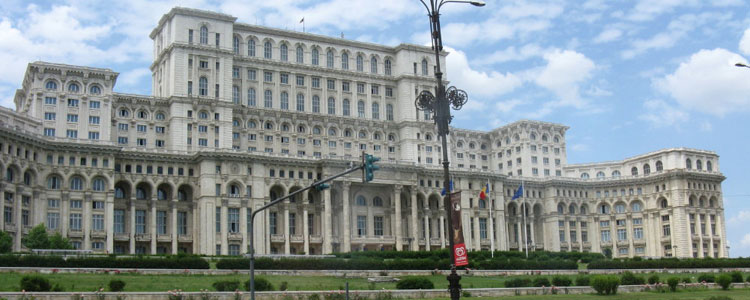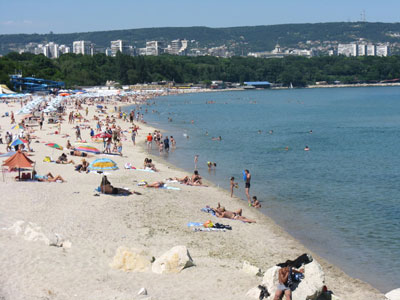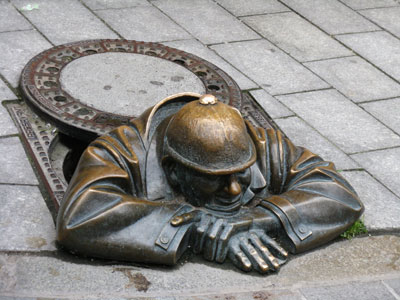Hitting high waters on a Danube River cruise
by Larry Taylor; Fullerton, California. Photos by Gail Taylor
We were certainly enjoying our June 2010 cruise up the Danube on Uniworld’s River Countess. The food was wonderful, the sites visited were interesting, and life aboard was relaxing. However, on our fifth day on the river, we were wondering why the captain had suddenly called a special meeting. We soon found out why: our cruise would be over the next day, midway through our itinerary.
We had noticed that the water level had been rising, and we could see how the banks were overflowing into the trees along the shore. During the meeting, we were told that the Serbian government had halted river traffic because of flooding from heavy rains to the north. Authorities said it was no longer safe to travel, and all vessels would be stopped for an estimated three days.
Our captain, Jord Zwaal, was frustrated, of course, and when asked to describe what, exactly, was happening, he said it was like a small tsunami on the river, as if a wall of water was coming toward us that would lift the river level. He said he didn’t want to keep us stranded in Belgrade, so passengers would disembark the next day and the remainder of our trip would be by bus, with nights spent in hotels.
An overview
We had begun this 16-day “Eastern Europe Explorer” trip in Bucharest. After two nights there, the 70 passengers boarded the River Countess for what was supposed to be the remainder of our journey. Countries to be visited, besides Romania, were Bulgaria, Serbia, Croatia, Hungary, Slovakia and Austria.
As it turned out, we did visit all the countries specified on our itinerary and saw most of the sites scheduled. Traveling by bus was not a circumstance we would have chosen, but, as all seasoned travelers realize, stuff happens and plans have to be adjusted.
All countries on the tour, except Austria, had been under Russian domination after World War II. With the collapse of the Soviet empire in 1991, all became independent. Old borders were restructured and some areas renamed.
Most interesting were the stories guides told of the changes brought on by the new freedoms in these countries and the comparisons they made about life before and after gaining independence.
As explained to us, life for everyone is not necessarily better now. Under communism, lives were structured, basic needs (medical, housing) were taken care of by the government and there was nearly full employment. Now, with capitalism, individuals are on their own and some are having economic difficulties.
All these Eastern European nations are now experiencing a rise in tourism. Consequently, we found most to be refreshingly “untouristy.” Crowds were comparatively small, and local people were welcoming and friendly.
Each country had a different language, but those used to dealing with travelers had a good command of English.
Beginning in Bucharest
After arriving in Bucharest, the group of 70 booked for the cruise stayed in the Radisson Blu Hotel for two nights before being driven the short distance to the port city of Giurgiu.
A highlight in Bucharest was our city tour, which included a visit to the Parliament Palace. Built by the notoriusly despotic Communist Party leader Nicolae Ceaus¸escu, this colossal building is the second-largest administrative building in the world, after the Pentagon.
When construction started in 1984, Ceaus¸escu intended it to be the government headquarters as well as his home. However, it was his fate to be executed before it was finished. Today, it houses Romania’s Parliament and serves as an international conference center, but many of the rooms remain unoccupied.
We toured the interior with its luxurious display of crystal chandeliers, mosaics, oak paneling, marble, gold leaf, stained-glass windows and floors covered in rich carpets.
Also memorable was the visit to Revolution Square, in the heart of the city. Anchoring the square is the former Communist Party headquarters. This was where, during the revolution in 1989, Ceaus¸escu looked out from the balcony and, in disbelief, saw the multitudes of people who had turned against him. He and his wife fled but were captured only hours later.
At the top of the list of things to do outside Bucharest is visit Transylvania and Bran Castle. On our day-long excursion, the lush countryside was ablaze with red poppies amongst a rainbow of wildflowers, a benefit of the spring’s heavy rains.
Our bus drove into the densely wooded Carpathian Mountains, then dropped down into the verdant Bran Valley, where the castle stands against the hills. If it weren’t for the souvenir sellers who greeted us, the setting would have looked like one from the movies.
Referred to by some as Dracula’s Castle, though it has only a tenuous association with Vlad Tepes, the man upon whom the character was loosely based, the castle is now a national monument. Though filled with tourists, its secret passageways and concealed rooms imparted a spooky aura. For vampire fans, the top floor is filled with paraphernalia from Dracula lore.
During our two nights on the town, we found a very good restaurant, La Mama (Episcopiei 8), near the Romanian Athenaeum concert hall. It’s known for its authentic Romanian food. We told our waiter we wanted something “ethnic.” On his advice, we ordered sarmale (cabbage rolls) accompanied by the traditional mamaliga (cornmeal mush), with delicious fresh beets as a side dish. The meal cost around $30 with drinks, coffee and dessert. We liked our selection so much, we ordered it both nights.
Side note — Romanian, as one of the Romance languages, has much in common with French, Italian, Portuguese and Spanish. We recognized many phrases, such as “Bună seara” — close to the Italian “Buona sera,” which means “Good evening.” In other countries we visited, Slavic languages were spoken.
Cruising on
After Bucharest, we boarded our ship, the River Countess. Having read that this ship was voted the best river cruise ship afloat, we were very excited, and we were not disappointed. Not only were the accommodations well planned and elegant but the entire ship was tastefully decorated, from the spacious lounge in the front of the ship to the dining room at the back. Of the countless cruises we’ve taken, the dining experience on this ship was among the very best.
The next morning we sailed to the other side of the river to Rousse, Bulgaria, where we boarded a bus for a day-long excursion to the Black Sea resort town of Varna. After lunch, we walked along the beach there, with some of us going into the 70-degree water. It felt very pleasant on a hot day.
Our next two days of sightseeing in Bulgaria proved to be among the most memorable of the trip. We started with a visit to Veliko Tarnovo, the site of the medieval Tsarevets castle with its surrounding wall seemingly continuing into the valley below. This imposing castle was a fortress and royal palace from 1185 to 1393.
We continued on to Arbanasi, which attracts visitors worldwide to its ancient Orthodox churches dating back to the 1500s. Particularly striking was the Christ Nativity Church, its walls and ceiling bedecked with brilliant frescoes and icons. Not noticeably faded over the ages, they vividly portray the rewards of heaven and the perils of hell.
A bit later we went to the church of St. George to hear a blissful concert performed by a church chorus.
Our last day in Bulgaria was particularly memorable, with visits to Baba Vida fortress and the Belogradchik Rocks.
Located on the western slopes of the Balkan Mountains, these oddly shaped rock formations vary in color from red to gray to yellow. Some 600 feet in height, many of the rocks are associated with local legends. The rocks are incorporated into the fortress, built during the 10th century.
Many of us took the path leading to the tallest section of the rock fortress. It was not easy — 200 steps in 102-degree heat. Sweating and panting, I wondered, halfway up, what I was doing there, but I persevered.
During the last day aboard ship, we were enthralled as we sailed to Serbia through the Iron Gates, comprised of an 80-mile sequence of gorges cutting through the Carpathian Mountains. It is rated among the most dramatic natural displays of beauty in Europe.
Prior to 1972, when the Iron Gate I
Dam was constructed, a trip along this stretch could be hazardous. Now, two locks raised our boat to dam level and we were on our way — until the high water stopped us later that day.
Continuing by land
Before disembarking, we spent two days on excursions in Serbia’s capital, Belgrade. First was a trip to the Kalemegdan Fortress, located atop a ridge overlooking the confluence of the Danube and Sava rivers. There we saw reminders of Serbia’s Roman and medieval past. Most of the area is now a park.
Later that day we went to the National Museum and saw a treasure trove of pieces excavated at the fort, including sculptures, weapons, helmets and other items from ancient Rome and Greece. The most valuable and impressive pieces are golden masks from the sixth century BC.
Also very interesting was our stop at the mausoleum of Marshal Tito, the former leader of Yugoslavia. As president, he and his government managed to keep the country the most independent one in the Eastern Bloc*. He is a well-loved figure, and his white-marble grave sits in the center of an airy glass-and-stone pavilion. On exhibit is an interesting array of memorabilia from his era.
The following morning we boarded buses for a trip that would cross the borders of three countries: Serbia, Croatia and Hungary. The day was broken up by a delightful lunch in the home of a family in a village near Osijek, Croatia. (Actually, because of the size of our group, several homes were chosen.)
Speaking for our host family was the teenage daughter, whose English was flawless. Her mother and younger sister could speak a little English, but she took the floor and had a delightful manner. She answered all of our questions about Croatian life. The meal was wonderful, especially the vegetable soup and fried chicken.
We toured the Old City of Osijek before going on to Budapest, Hungary.
A few final days
That evening we checked into our hotel on the Danube, located right across from Budapest’s Parliament Building, which is lit up at night. We also had a view of the famous Chain Bridge, built in the early 19th century to link the two parts of the city: Buda and Pest.
The city is regarded as one of the most beautiful in Europe. Regretfully, we had only one full day there, which forced us to cram in visits to some of the most obvious sites, including a tour of Buda Castle with its fairy-tale turrets; a brief look at magnificent St. Matthias Church, and a walk around the vast Heroes’ Square with, along massive walls, its carvings of significant happenings in Hungarian history.
Making a fortuitous decision, we chose an afternoon trip to Szentendre, a picturesque village with typical Hungarian arts and crafts on display. Most of our fellow travelers shopped along the cobblestone streets, but we decided to take in a museum devoted to Margit Kovács, a highly praised mid-20th-century ceramicist.
Featured was a collection of clay statuettes, pots, plates, wall plaques and tiled murals. Her art is varied but characterized by sensual flowing lines. Altogether, it turned out to be an eye-opening experience.
Our final day consisted of driving across neighboring Slovakia. At noon we took a half-day break to walk around the pleasant capital, Bratislava. The Old City proved to be very compact and accessible. The narrow streets, quaint buildings and spacious squares made it look picture-book perfect.
Soon after starting our tour, we were surprised to see a bronze statue of the American pop artist Andy Warhol. It turns out that his parents came from northeastern Slovakia. This was just the first of many whimsical life-size bronzes we saw.
We finished up this pleasant afternoon with a concert performed by the first violinist and piano-conductor of the Slovak National Symphony Orchestra.
That evening we had a lavish dinner of Austrian specialties at Vienna’s famous Marchfelderhof. Two days more in wonderful Vienna and our “cruise” was over.
By the way, after a very speedy sail, the River Countess made it to Vienna, where the next group was ready to embark on a cruise from there to Amsterdam.
Uniworld (Los Angeles, CA; 800/733-7820) offers river cruises throughout Europe as well as in Egypt and China. As a freelance journalist, I received a 65% discount off the cruise-only price. For 2011, prices range from $4,399 to $7,124, depending on cabin category and departure date.
Editor’s note: Outside of those written by staff and Contributing Editors, ITN normally does not publish Feature Articles written about trips that were sponsored or discounted, but since this subscriber’s experience involved a curtailed river cruise, a subject discussed in a previous issue, and it was one which employed successful alternate touring arrangements, an exception was made.
*Bloc parting CORRECTION (Published July '11, pg. 53) — We thank subscriber Christine Zohar Olson of San Francisco, CA, for bringing to our attention an error in the June ’11 Danube River article. It was stated, on page 39, that Yugoslavia when under the leadership of Marshal Tito was an Eastern Bloc country. As Christine wrote, “Starting with the Tito-Stalin split, which occurred in 1948, Yugoslavia was not part of the Eastern Bloc. It was part of the Non-aligned Nations.” — Editor





